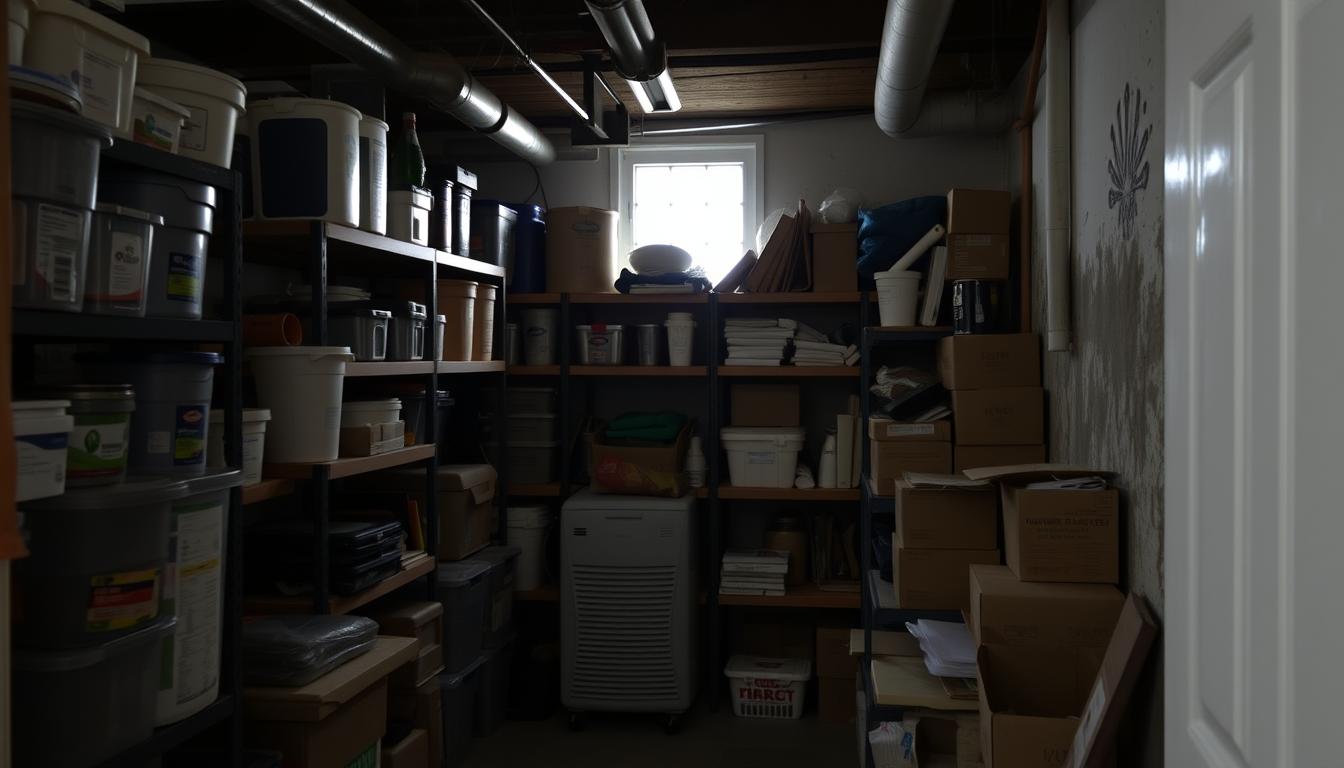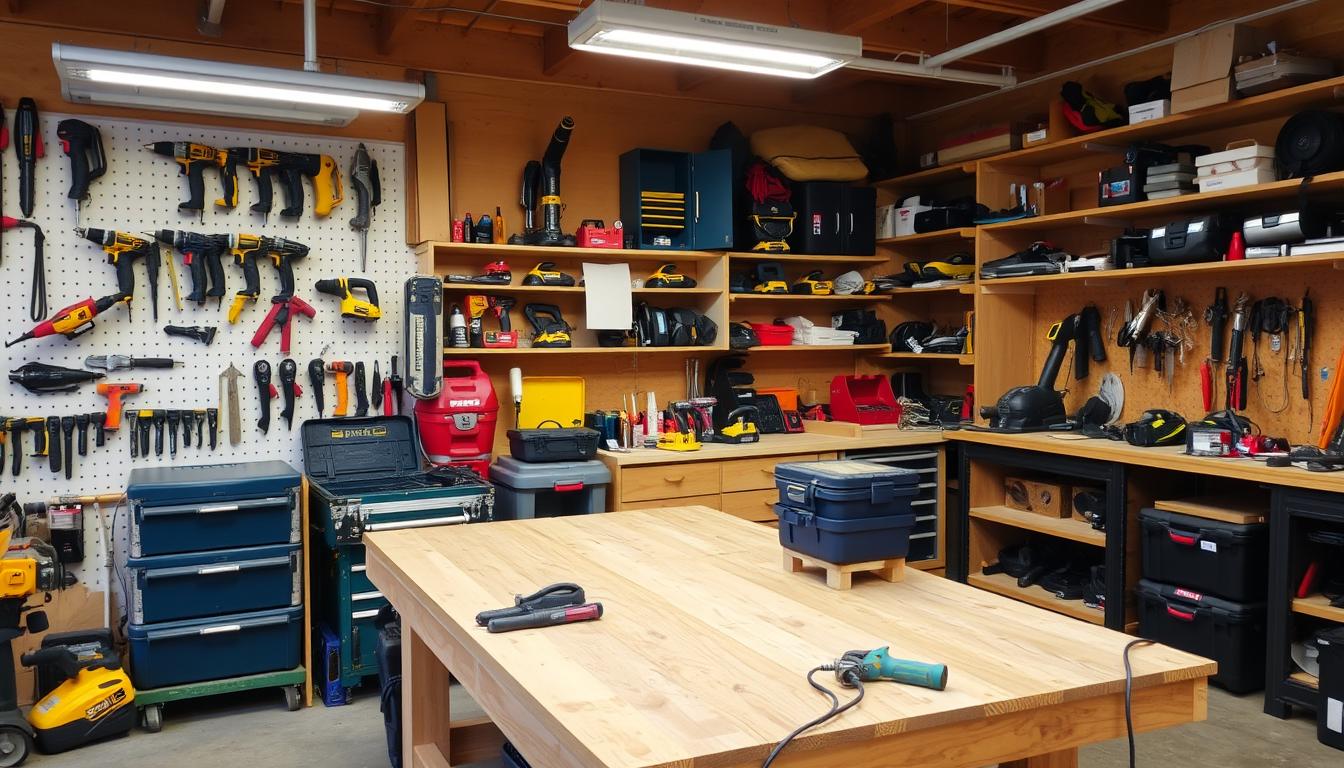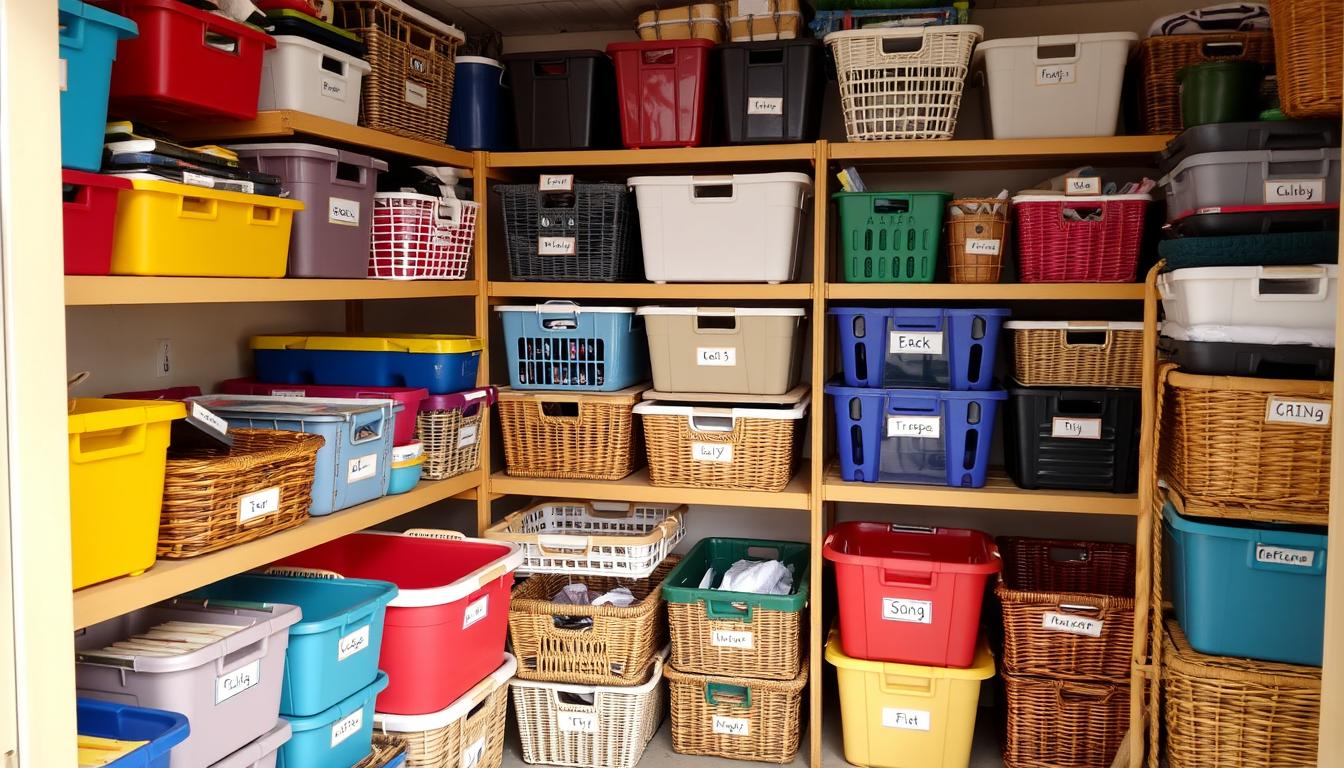The basement is often overlooked when it comes to maximizing home storage. Effective organization and systems can transform it into a functional space. Understanding the challenges of moisture and space is key to unlocking your basement’s potential.
Basement storage can revolutionize your home, offering a dedicated area for less-used items. With the right setup, your belongings will be safe, dry, and accessible. This article will guide you through creating an organized and functional basement storage space.
Key Takeaways
- Basement storage can provide a significant amount of additional storage space for your home
- Effective basement organization is crucial for maximizing storage potential
- Basement systems, such as waterproofing and climate control, are essential for maintaining a dry and safe storage environment
- Proper planning and design are necessary for creating a functional and efficient basement storage space
- By investing in basement organization and basement systems, you can protect your belongings and increase the value of your home
Understanding Your Basement Storage Potential
To create a functional and safe storage space, it’s essential to understand your basement’s potential. This involves assessing the available space, identifying problem areas, and evaluating environmental conditions. By considering basement shelving and storage safety, homeowners can maximize their storage capacity while ensuring a secure environment.
When evaluating your basement, start by measuring the space to determine the best layout for your storage needs. Consider the location of windows, doors, and any obstructions that may impact your storage plans. It’s also crucial to identify potential hazards, such as water damage or pest infestations, and address them before installing basement shelving.
Assessing Available Space
A thorough assessment of your basement’s available space will help you determine the most efficient storage solutions. Consider the following factors:
- Room dimensions and layout
- Location of windows, doors, and obstructions
- Condition of the walls, floor, and ceiling
Identifying Problem Areas
Identifying problem areas in your basement is critical to ensuring storage safety. Look for signs of water damage, pest infestations, or other hazards that may impact your storage plans. By addressing these issues, you can create a secure and functional storage space.
Common Moisture Challenges in Basements
Basements often face moisture challenges, which can cause damage and health problems. Moisture control is key to avoiding these issues. Homeowners deal with flooding, humidity, and water damage due to poor ventilation, leaky pipes, or heavy rain.
To tackle these problems, identifying moisture sources is crucial. Steps include installing a dehumidifier, fixing leaks, and enhancing ventilation. These actions help reduce moisture-related risks and ensure a healthier storage area.
Signs of moisture issues in basements include:
- Water stains or discoloration on walls and ceilings
- Musty odors or mold growth
- Peeling paint or wallpaper
- Warped or damaged flooring
Recognizing these signs and acting early can safeguard belongings and create a safe storage space.
Effective moisture control prevents damage and health risks. Understanding moisture causes and controlling it leads to a dry, healthy basement environment.
| Moisture Challenge | Cause | Solution |
|---|---|---|
| Flooding | Heavy rainfall or leaky pipes | Install a sump pump or fix leaks |
| Humidity | Poor ventilation | Install a dehumidifier or improve ventilation |
| Water damage | Leaky pipes or poor drainage | Fix leaks or improve drainage |
Essential Basement Waterproofing Methods
Basement waterproofing is vital to prevent water damage and ensure a dry storage area. Homeowners should focus on effective methods to keep their basements dry. A dry basement is crucial for storing valuable items, and waterproof storage solutions offer peace of mind.
To achieve a waterproof basement, it’s essential to consider the following methods:
- Foundation sealing techniques to prevent water seepage
- Drainage solutions to redirect water away from the basement
- Dehumidification systems to control humidity levels
By implementing these methods, homeowners can create a secure and dry storage space for their belongings. Waterproof storage solutions can be tailored to meet the specific needs of each basement. This ensures that valuable items are protected from water damage.
| Method | Effectiveness | Cost |
|---|---|---|
| Foundation sealing | High | Medium |
| Drainage solutions | High | High |
| Dehumidification systems | Medium | Low |
By selecting the right waterproofing method and considering waterproof storage solutions, homeowners can protect their belongings. They can also create a dry and secure storage space.
Smart Basement Storage Solutions
Basements face unique challenges, including moisture issues. This can damage stored items and foster mold and mildew growth. To address this, homeowners can install climate control systems. These systems maintain a stable temperature and humidity level.
Designing a smart basement organization system is crucial. It maximizes storage space while keeping items dry and secure. Modular storage systems and climate-controlled units are popular choices. They cater to specific needs and provide a stable environment for sensitive items.
Smart basement storage solutions offer several benefits:
- Improved climate control prevents moisture damage and reduces mold and mildew risks.
- Increased storage capacity is achieved through modular systems and vertical storage.
- Enhanced organization helps homeowners quickly locate items, maximizing storage space.
Investing in smart storage solutions creates a safe, dry, and functional space. It meets your needs and offers peace of mind. Whether storing seasonal decorations, out-of-season clothing, or important documents, a well-designed system is essential.
Organizing Your Basement Space Efficiently
Maximizing your basement’s storage potential requires efficient organization. This means creating a space that is both functional and safe. By using effective shelving and safety measures, you can protect your belongings and keep them easily accessible.
To achieve this, consider dividing your basement into zones. Each zone should have its own purpose, such as storage, a workshop, or a recreational area. Proper zoning helps maximize space and prevents clutter.
Zoning Strategies
- Designate a specific area for storage, using basement shelving and containers to keep items off the floor
- Create a workshop or hobby area, with a dedicated space for tools and equipment
- Consider adding a recreational space, such as a home gym or entertainment area
Vertical Storage Options
Utilize your basement’s vertical space with wall-mounted shelves, hooks, and storage units. This approach keeps your floor clear, enhancing the sense of openness. It also ensures storage safety.
| Storage Option | Description |
|---|---|
| Wall-mounted shelves | Perfect for storing boxes, bins, and other containers |
| Hooks | Great for hanging bikes, tools, and other equipment |
| Storage units | Ideal for storing seasonal decorations, out-of-season clothing, and other items |
By implementing these strategies, you can create a safe and functional basement space. It will meet your needs and provide ample storage safety.
Climate Control for Basement Storage
In basement storage, climate control is key to a stable environment. It’s vital for items that could be harmed by extreme temperatures or humidity. A climate control system keeps belongings safe and secure.
Effective climate control means managing temperature and humidity to avoid moisture buildup. Dehumidifiers, heaters, and air conditioners can help. It’s important to pick the right system for your basement, considering size, insulation, and ventilation.
Some key considerations for climate control in basement storage include:
- Maintaining a consistent temperature between 60-70°F (15-21°C)
- Keeping humidity levels below 60%
- Ensuring proper ventilation to prevent moisture accumulation
By following these steps, homeowners can create a stable storage environment. This protects their belongings from damage.
Also, moisture control is essential in basement storage. It prevents mold and mildew growth, which can harm stored items. A well-designed climate control system maintains optimal moisture levels, ensuring a safe storage space.
Selecting Moisture-Resistant Storage Containers
Choosing the right containers for your basement storage is key to avoiding moisture damage. Basements often face dampness issues, making waterproof storage essential. We’ll look at various moisture-resistant containers, including plastic and metal options.
Homeowners have many storage container choices, each with unique benefits. Plastic containers are light, easy to clean, and rust-resistant. Metal containers, on the other hand, are durable and can handle heavy loads. Containers with silicone seals or desiccant packets add extra moisture protection.
Container Options
- Plastic storage containers: ideal for storing lightweight items, such as clothing or linens
- Metal storage containers: suitable for storing heavier items, such as tools or equipment
- Specialized moisture-proof containers: perfect for storing sensitive items, such as electronics or important documents
Regular maintenance is crucial for your containers’ longevity. Clean them often, check for damage, and replace them when necessary. By choosing moisture-resistant containers and maintaining them well, homeowners can safeguard their belongings from moisture damage. This ensures the basement systems remain intact.
Container Maintenance Tips
To keep your storage containers in good condition, make sure to:
| Tip | Description |
|---|---|
| Regular cleaning | Wipe down containers with a dry cloth to prevent moisture buildup |
| Inspect for damage | Check containers for signs of rust, cracks, or other damage |
| Replace as needed | Replace containers that are damaged or no longer waterproof |
By following these tips and choosing the right containers, homeowners can enjoy a dry and secure basement storage environment. This is thanks to effective waterproof storage and well-designed basement systems.
Safety Considerations for Basement Storage
Ensuring safety is paramount when organizing your basement for storage. A well-organized space can significantly reduce the risk of accidents. It’s vital to focus on fire safety, pest prevention, and emergency access planning.
Effective basement organization plays a crucial role in preventing fires and ensuring quick escape in emergencies. Key considerations include:
- Keeping flammable materials away from heat sources
- Ensuring good ventilation to prevent moisture buildup
- Installing smoke detectors and ensuring they are functioning properly
Preventing pests is equally important for a safe storage environment. This can be achieved by:
Sealing any cracks or crevices to prevent pests from entering, and using storage containers that are resistant to pests and moisture. These measures help protect your belongings from damage and ensure storage safety.
By focusing on storage safety and organization, homeowners can create a secure and functional space. This not only prevents accidents but also offers peace of mind, knowing your belongings are safe and secure.
| Safety Measure | Description |
|---|---|
| Fire Safety | Install smoke detectors, keep flammable materials away from heat sources |
| Pest Prevention | Seal cracks and crevices, use pest-resistant storage containers |
| Emergency Access | Ensure clear escape routes, install emergency lighting |
Maintaining Your Basement Storage System
To keep your basement storage system running smoothly, regular maintenance is essential. This involves checking for moisture damage, pest infestations, and wear on your basement shelving. Regular checks help avoid expensive repairs and keep your storage area clean, dry, and safe.
Effective climate control is also crucial for your basement storage system. Use dehumidifiers, ensure proper ventilation, and insulate well. This approach prevents moisture buildup and pest infestations.
Here are some tips for maintaining your basement storage system:
- Regularly inspect your basement shelving for damage or wear
- Look for signs of moisture or water damage
- Make sure ventilation and climate control are proper
By following these tips and maintaining your system, it will stay functional and efficient for years.
Conclusion: Creating Your Ideal Basement Storage Space
By following the strategies and techniques outlined in this comprehensive guide, you can transform your basement into a well-organized, moisture-controlled storage haven. Implementing proper waterproofing, investing in appropriate storage solutions, and maintaining a climate-controlled environment are essential steps. These steps help create your ideal basement storage space. With a keen eye for detail and a commitment to consistent upkeep, you can enjoy a secure and accessible storage area that meets your household’s needs.
Remember, taking proactive measures to address moisture control is the key to preserving your belongings. It ensures the longevity of your basement storage system.






